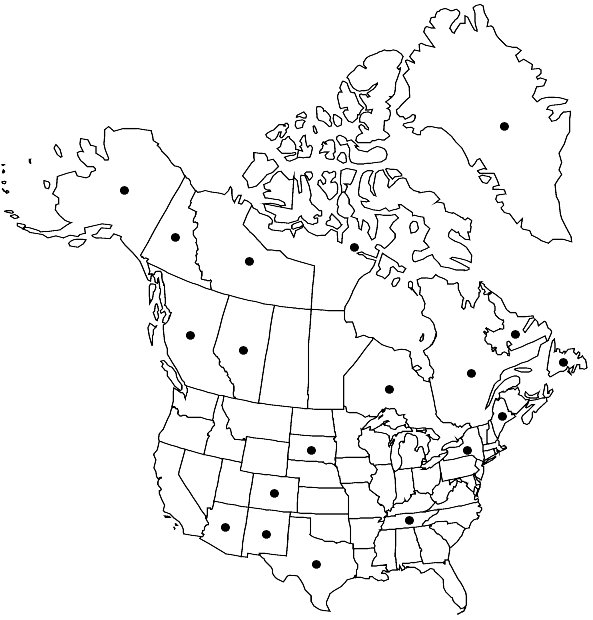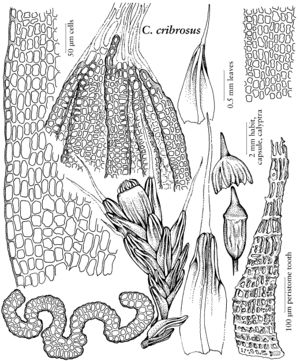Coscinodon cribrosus
Ann. Mag. Nat. Hist., ser. 2, 3: 491. 1849,.
Plants 4.5–7 mm, dark olivaceous. Leaves oval to ovate-lanceolate, 1.1–1.9 × 0.4–0.7 mm, margins incurved distally, apex plane, awn 0.1–1.1 mm, lamina 2-plicate, plications not always reaching base; basal juxtacostal laminal cells quadrate to long-rectangular, 20–47 × 8–12 µm, evenly thick-walled; basal marginal laminal cells quadrate to rectangular, 12–34 × 6–12 µm, thin or thick end walls and thin lateral walls; medial laminal cells 1-stratose; distal laminal cells 2-stratose. Sexual condition dioicous. Seta 0.8–1.2 mm. Capsule emergent, ovoid to campanulate; peristome present, cribrose, hygrocastique.
Habitat: Acidic, dry sandstone, shale, and granitic boulders and bedrock exposures but also found on volcanic outcrops and granodiorites
Elevation: low to high elevations (0-3300 m)
Distribution

Greenland, Alta., B.C., Nfld. and Labr., N.W.T., Nunavut, Ont., Que., Yukon, Alaska, Ariz., Colo., Maine, N.Mex., N.Y., S.Dak., Tenn., Tex., Eurasia.
Discussion
Coscinodon cribrosus is an uncommon moss known from widely disjunct sites across North America. It has been suggested that this distribution is due to a restricted occurrence on mineral-rich rocks. The sites from Ellesmere Island, Tennessee, Colorado, South Dakota, Thunder Bay, and Alaska support this contention, as they are all reported to be either heavy-metal- or copper-bearing deposits or the specimens are associated with the “copper-moss,” Mielichhoferia mielichhoferi. However, specimens from other areas have been collected on sandstones and shales. The distribution appears to have been largely controlled by the extent of the Cretaceous epicontinental seaway that flooded much of central North America from the Gulf of Mexico to the Yukon (R. I. Hastings 1999). The species does not occur within the boundaries of the seaway except on isolated granodiorite outcrops that were exposed subsequent to the retreat of the seaway. Coscinodon cribrosus is recognized by its 2-plicate, 2-stratose leaves with incurved margins and emergent capsule with a well-developed cribrose peristome. It is the only species of the genus that has a hygrocastique peristome, i.e., its peristome opens when wet and is closed when dry.
Selected References
None.
